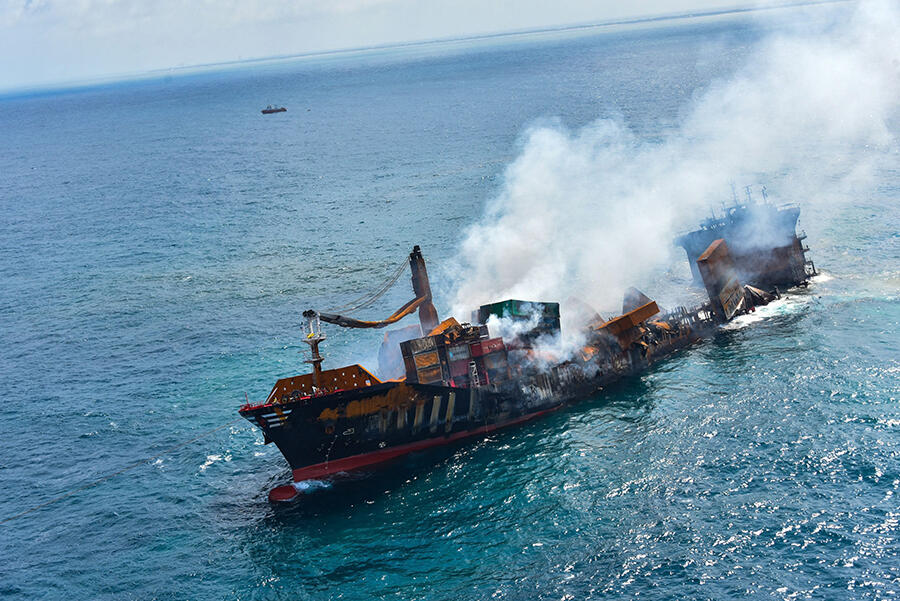You are here
Can international law save the oceans?

At a meeting in New York on 4 March, the UN member states finally agreed on an international treaty to increase protection of the oceans, after nearly twenty years of talks including four of formal negotiations. Why is this being hailed by NGOs as a turning point?
Pascale Ricard:1 The agreement aims to improve the protection of biodiversity in international maritime zones, i.e. located more than 200 nautical miles (370.4 km) off the coasts, and comprising both the high seas and the seabed beyond national jurisdiction. This covers 64% of the ocean surface, in other words, almost half that of the Earth. Although the text has yet to be formally adopted after legal validation, its content can no longer be significantly changed.
This treaty really is decisive, and provides a specific legal framework for two essential new instruments that will enable governments and international organisations to take action to conserve the biodiversity of these sectors. First of all, it facilitates the creation of marine protected areas enforceable against all signatory States. It then defines the procedures for implementing the general obligation to carry out environmental impact studies for all activities carried out in – or likely to impact – international maritime zones.

The agreement is not only concerned with conservation though. It also addresses the ‘sustainable use’ of biodiversity and in this context clarifies the legal status and modalities of exploitation of marine genetic resources. The ecosystems beyond national jurisdiction are very diverse, such as in the polar regions, or around deep hydrothermal vents, which are home to extremophile organisms of both animal and plant origin. Such organisms, which sometimes live without light and at very high or low temperatures, are highly prized by the pharmaceutical and cosmetic industries for the considerable profits they could generate.
This particular question has long raised issues of equity between developed and developing countries. The former wished to maintain a system permitting free access to and exploitation of genetic resources. The latter, lacking the necessary technologies, called for strict supervision and sharing of their potential benefits, similar to the ‘common heritage of mankind’ rules that apply to the international seabed area and its mineral resources under the Montego Bay Convention. A compromise between these two positions has now been reached, setting up a framework for access to these resources and the sharing of benefits resulting from their exploitation. Finally, the treaty devotes a whole series of provisions to capacity-building and technology transfer for developing countries, so that they can effectively fulfill their obligations.
The Montego Bay Convention which you mentioned is widely seen as a sort of ‘constitution’ for the oceans, isn't it?
P. R.: Yes. The United Nations Convention on the Law of the Sea (UNCLOS), which was signed in Montego Bay, Jamaica, in 1982 and came into force in 1994, defines and regulates maritime areas. Territorial seas, which are under the full sovereignty of coastal States, begin where the internal waters end, at the baseline, and extend 12 nautical miles (22,224 km) offshore. Beyond this is the Exclusive Economic Zone (EEZ), which stretches out to 200 nautical miles (370.4 km). Although States don't have total sovereignty within this zone, they enjoy sole exploitation rights over resources on the continental shelf beneath the EEZ. Based on a number of geomorphological criteria, this distance can be extended out to 350 nautical miles (648.2 km). Beyond the EEZ and the continental shelf, it is necessary to make a distinction between the high seas and the international seabed area, both of which are covered by the new agreement after having long been ignored in the environmental debate.
For all these zones, the Convention lays down, in particular, general obligations regarding the protection of the marine environment and fishery resources. Nonetheless, these provisions are very insufficiently implemented by States, since they are not worded precisely enough and above all are not regularly monitored and controlled, especially in areas located a long way out to sea. This is what led to the opening of negotiations for the treaty that is now about to be adopted.
The oceans are not only exploited for their biodiversity, they are also affected by pollution, especially plastic waste. In recent months, this issue has come to the fore again with the massive washing up on France's Atlantic coast of ‘mermaid tears’, tiny plastic beads that are used as the raw material for plastic objects. What liability regime applies to this type of environmental disaster?
P. R.: The case of these industrial granules provides an iconic illustration of the pollution of the seas and oceans by plastics and microplastics. These beads can easily be spilled throughout the many stages of the production chain and are very light. Transported by winds, currents or animals, they can cause harm a very long way from their point of origin. It is therefore difficult to take legal action against such pollution, estimated worldwide at 230,000 tonnes per year,2 since identifying the polluter and collecting evidence is very tricky, if not impossible, and responsibilities vary depending on where it occurs. In France, a decree that came into force in January 2022 requires all sites that produce, handle and transport industrial plastic granules to adapt their facilities and implement procedures to prevent them being discharged into the environment. But this only solves part of the problem.

What happens when the source of the pollution is located beyond national jurisdiction, for instance when containers are lost overboard on the high seas?
P. R.: When an incident occurs on the high seas, it is the flag State that has exclusive jurisdiction over the damage caused by the ship.
Yet much of the world's merchant shipping fleet operates under flags of convenience, registered in States chosen for their weak jurisdiction regarding taxation, environmental standards and labour law. The case of plastic pollution highlights the gap between, on the one hand, the physical continuity and connectivity of the oceans, and on the other, the regime they are subject to, which is highly fragmented both geographically and legally.
Aren't there any international conventions concerning plastic waste pollution?
P. R.: The International Maritime Organisation (IMO) was established in 1958, but it wasn't until the 1970s that environmental concerns were added to its initial mandate to regulate human safety and physical security at sea. In that decade, two major conventions were adopted to prevent pollution from ships.3 In particular, they serve as a basis for sanctions adopted by States.

In addition to these two international treaties, the 1982 Law of the Sea Treaty (UNCLOS) mentioned above provides a general framework that incorporates all the obligations of the IMO conventions and applies to all types of pollution, including of course plastic waste, in all areas. It enshrines the principle of preventing and combating every kind of contamination, even though it doesn't yet mention biodiversity. Part XII deals exclusively with the protection and preservation of the marine environment. Today, 168 States are parties to the Convention, and plastic pollution is on the agenda of many international organisations, including the FAO, which is responsible for fisheries. Again, although these various agreements provide a wide range of instruments, implementing them remains complicated, particularly because of the difficulty and cost of the monitoring required.
Is progress likely in the near future?
P. R.: In 2014, the United Nations Environment Assembly (UNEA) adopted a resolution highlighting the problem of plastics and microplastics in the ocean. It commissioned a study from a special group of experts, which proposed several options: the signature of an international treaty, the establishment of an international compensation mechanism, or a science/decision-making interface on chemical and plastic pollution based on the model of the IPCC. In February 2022, the States decided to open new negotiations aimed at adopting a treaty. The UNEA is very ambitious both in its objective, which is to put an end to plastic contamination, and in its timetable, which seeks to have the document ratified by the end of 2024. The first round of negotiations was held in Uruguay in December, and the next will take place in May 2023 in Paris.
What would be the scope of this new treaty?
P. R.: There is no consensus as yet. Some States believe that the treaty should cover the entire life cycle of plastic, from production to destruction. Some organisations are calling for annual exit targets to be imposed on governments and businesses alike, along the lines of the 2015 Paris Agreement. In January, three of them took the agri-food giant Danone to court in a bid to force it to plan a ‘deplastification trajectory’. Others would prefer the treaty to be restricted to the issue of waste.

How does your laboratory contribute to these talks?
P. R.: My laboratory takes part in the work of the International Centre for Comparative Environmental Law (CIDCE), which brings together specialised lawyers from around the world to help advance environmental legislation at international and regional meetings and conferences. Together with my colleagues Sophie Gambardella, Ève Truilhé and Marie-Pierre Lanfranchi, we have undertaken a review of plastics regulation in French and international law and published a number of articles on these questions.4
Is an international treaty really the format best suited to the urgency of the environmental situation?
P. R.: It's true that the wheels of diplomacy turn exceedingly slowly. Today's major environmental threats, such as climate change, biodiversity loss and plastic pollution, are complex and global, and this requires the participation of as many countries as possible, even if it means reducing the scope and ambition of the agreement. This discrepancy is increasingly leading to the development of so-called ‘soft law’ mechanisms. This is the case, for example, of the Global Biodiversity Framework adopted at the COP15 biodiversity conference last December. It is not as legally binding as a treaty but is immediately applicable, without the need for ratification. One of its key measures, ‘30 by 30’, sets the goal of protecting 30% of maritime and land areas by 2030. The agreement recently reached in New York should facilitate its implementation.
- 1. CNRS researcher, Centre for International and European Studies and Research (CERIC), International, Comparative and European Law unit (CNRS / Aix-Marseille Université / Université de Toulon).
- 2. According to the NGO Surfrider Foundation, which makes it the second-largest source of so-called “primary” microplastic pollution of the oceans.
- 3. The London Convention, which was adopted in 1972 and came into force in 1975, was one of the first to protect the marine environment from human activities. In its Annex 1, paragraph 4, it prohibits the dumping of “persistent and floating” plastic waste, from ships, aircraft and platforms. The MARPOL Convention was adopted in 1973 and was enforced in 1983. It is the main international agreement covering the prevention of pollution of the marine environment from ships, whether caused as a result of operations or by accidents. Its Annex 5 addresses pollution by waste, including plastics.
- 4. Pascale Ricard was the editor of a special report for the magazine Confluence des Droits on the fight against plastic pollution in international, comparative and European law, available here (in French): https://confluencedesdroits-larevue.com/?page_id=1447(link is external)















